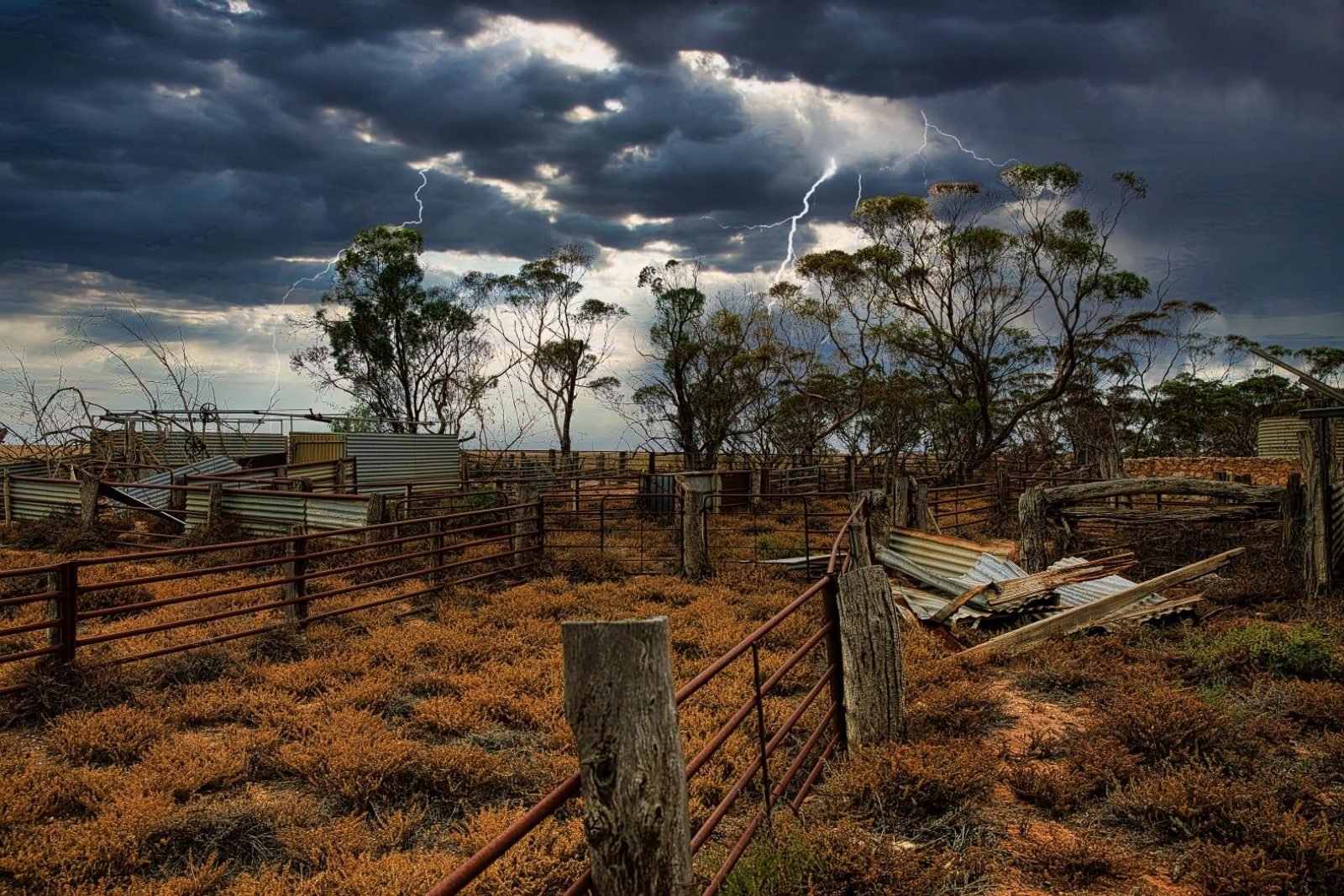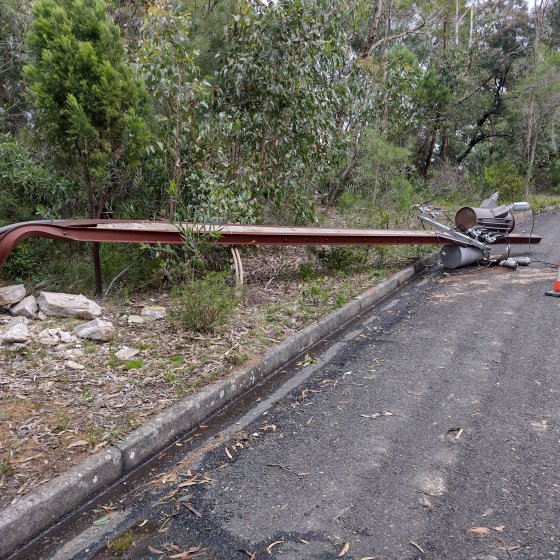- Home
- Environmental Themes
- Climate
- Impacts of Climate Change
- Extreme Weather
Extreme Weather
According to the Bureau of Meteorology, one of the greatest impacts of climate change is the severity and frequency of extreme weather events that include floods, fires, drought, thunderstorms, high-wind events and heatwaves. Heatwaves have caused more deaths in Australia than any other natural hazard. These events impact our environment, our communities and our wellbeing. The photo in the above banner shows a stobie pole that was bent during the 12 November 2022 storms which disrupted power supply to many residents in Adelaide and the Adelaide Hills.
An increased frequency of notable events has occurred in South Australia since 2018. A few notable events that have occurred in South Australia include (but are not limited to) the following:
2023
- On 23 June in the Adelaide Hills, heavy rainfall led to flash flooding, road closures and 7 swift-water rescues.
- Millicent had June monthly rainfall of 236 mm, the highest on record in 122 years, compared with a June monthly average of 106 mm.
- Keith had its lowest July minimum daily temperature on record, at –4.7°C.
- On 15 November, Coober Pedy suffered a maximum daily wind gust of 119 km/h, being the site’s strongest wind gust on record and destroying the town’s drive-in movie screen.
- Adelaide suffered storm damage to homes and other buildings in November, causing injuries, and intense rainfall (up to 45 mm in an hour at one location) caused flash flooding.
2022
- In January, parts of South Australia received more than four times the average January rainfall. The South Australian Government declared a major emergency to manage flooding and storm damage. The storm also resulted in impacts to transport corridors, which disrupted freight.
- More wild winds and flooding were experienced in Adelaide in June.
- Another severe storm hit Adelaide on 12 November, which brought wind gusts of up to 109 km/hr and 423,000 lightning strikes. Power outages were experienced by some residents for up to a week.
- The 2022–23 River Murray flood event was the largest since 1956 and resulted from heavy rain and floods that occurred interstate. The flow rate peaked at the South Australia/Victoria border at 186 GL per day on 22 December 2022. The flood resulted in significant property damage, restriction of recreational activities permitted on the river and impacts to our tourism and agriculture industries. Approximately 4,000 hectares of agricultural land and 3,500 private residents were impacted because of this event.
2021
- In January, a bushfire occurred near the town of Lucindale in the South East with some properties damaged and around 16,800 hectares burnt. A fire also broke out in Cherry Gardens in the Adelaide Hills.
- Severe hailstorms and tornadoes were experienced around the Adelaide Hills region during July. Ice covered the ground in many areas with some residents taking the opportunity to dust off their skis and toboggans.
- Storms hit South Australia in November resulting in destructive winds, hail and blackouts. Hardest-hit areas included the Riverland and Mid North regions.
2020
- Bushfires were still continuing on Kangaroo Island and a dust storm was experienced in areas of South Australia in January.
- And from one extreme to another, we had snow in September.
2019
- Australia’s hottest month on record was recorded in January with Adelaide experiencing its hottest day on record reaching 46.6°C on 24 January. Port Augusta reached 49.5°C that same day.
- Extreme wind conditions were observed during April, July and August causing damage to properties and dust storms. Damage consistent with a tornado was observed near Lucindale and Southend.
- A massive hailstorm ripped through the Riverland in November causing damage to a number of crops.
- In November, a significant bushfire occurred in Port Lincoln and another bushfire occurred in Yorke Peninsula. And who can forget the 2019–20 bushfires in Cudlee Creek and Kangaroo Island. Severe bushfires were also occurring across the east coast of Australia. In total, by the end of December, more than 5 million hectares had been burnt with 60,000 hectares being located in South Australia. A report was commissioned to investigate the conditions that led to these fires.
2018
- Hot and dry conditions in January were present during a major fire that occurred near Keith, resulting in 12,000 hectares being burnt and damage to twenty farming properties, with the loss of 6 houses and several thousand livestock.
- Gusty winds in April caused dust storms and property damage.
- Strong winds in November caused power outages and property damage.
Modification of our environment has also compounded the impacts of these extreme weather events. For example, urban development results in less permeable surfaces, which increases stormwater runoff that can lead to flooding of our waterways and roads. Mitigating these impacts requires better planning that considers potential impacts of extreme weather events.
The number of incidents the Country Fire Service (CFS) responded to in 2022–23 increased by 10%, and hours spent servicing incidents almost doubled compared with the previous year. The CFS advised that this is mainly due to the number of major weather events that required CFS assistance, including severe weather and the River Murray floods. The CFS has stated that it is critical that their crews are supplied with the appropriate resources to respond to any emergencies in the future.
Increased investment in mitigating and planning for extreme events and climate change will hopefully reduce the pressure and need for government to allocate resources for natural disaster funds that are ad hoc in timing and resourcing requirements. The Intergenerational Report 2023 produced by the Australian Government has stated that the Insurance Council of Australia estimates resilience funding could provide returns of $8.10 by 2050 for every $1 invested under current circumstances based on expenditure required to address natural disasters.
The South Australian Fire and Emergency Services Commission (SAFECOM) has developed a Disaster Resilience Strategy to help our government and community build their capacity and resilience to respond to extreme events. SAFECOM also administers a number of grant programs that aim to build disaster resilience and risk reduction.

Further Reading
- Extreme events – Australia State of the Environment report.
- Australian Climate and Weather Extremes Monitoring System – Provides information about climate and extremes of temperature and rainfall from the Bureau of Meteorology.
